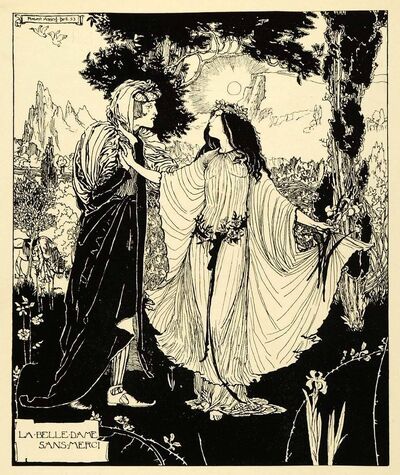
‘La belle dame sans merci’ (1920) by Robert Anning Bell
Overview
La Belle Dame Sans Merci is a poem written by John Keats in 1819 and later revised for publication in 1820. It is written using a standard ballad stanza, a quatrain in alternating iambic tetrameter and trimeter lines.
In the poem, an unnamed questioner finds a knight by a withering lake. He asks the knight, who is haggard and pale, what is making him so anguished. The knight then narrates his story of falling in love with a mysterious woman he met in the meadow. He describes her beauty with “long hair and wild eyes,” speaking in a “language strange.” He places her on his horse and they go to her home on the mountain, where she feeds him delicious food and they fall sleep. As he sleeps, he dreams of pale princes and kings who have all been cursed and enslaved by the beautiful lady. When he awakes, he is on the cold hillside beside the lake and the lady is gone.
Themes[]
Ambiguity of Perspective[]
In a letter he wrote to his brothers George and Thomas on December 22, 1817, Keats begins to explore a literary theory he terms “Negative Capability.” He describes this as a sublime place of tension in which there are two opposing forces paradoxically existing equally aside each other without domination. (Keatsian)
”I mean Negative Capability, that is, when a man is capable of being in uncertainties, mysteries, doubts, without any irritable reaching after fact and reason. Coleridge, for instance, would let go by a fine isolated verisimilitude caught from the Penetralium of mystery, from being incapable of remaining content with half-knowledge. This pursued through volumes would perhaps take us no further than this, that with a great poet the sense of Beauty overcomes every other consideration, or rather obliterates all consideration.” [1]
For Keats, great poetry exists when a poet can extract his own ego from his writing and open up a dual existing, negative space within conflict. An emotion where one could see all perspectives and personalities equally. In this poem, the space for open interpretation is achieved both structurally and linguistically.
Keats creates anxiety and an air of ethereal through a frame structure narrative and by manipulating the rhyme scheme and meter. By shortening the fourth line of each stanza, he creates a premature, unsatisfying closure to each stanza, forcing the rhythm to stop. The reader is left with the feeling that there is more to the narrative than what is being revealed.
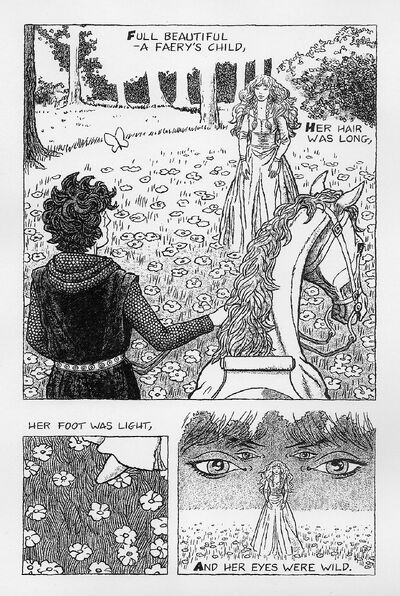
Julian Peters
Sympathy for the knight is achieved through the tightly focused, emotional first person narrative. However, for a critical reader examining this poem from the woman’s perspective, this also adds a skepticism to his authority. The knight himself does not explain his own actions, and in the tradition of ballad and of courtly love, one does not question his motives other than the simplicity of his love and subsequent innocent victimization, and hers as a wanton succubus. Yet again, the neutrality of Keats’s language and narrative framework allow just enough space to ask of the motivations of each of these characters. One can examine where the knight may have been perceived as threatening or why the woman may have been dangerous. He first describes her “with eyes wild,” perhaps meaning that she was not understanding of his language or culture. He then binds her with flowers about her wrists and waist, and places her on his horse. He does not state where he was planning on taking her, only that she was beautiful, and that by binding her he had claimed her for his own.
“She looked at me as she did love”- Does this mean she looked at him with love, or she looked at him as if she loved him?
“And sure in language strange she said—
‘I love thee true’.”
Many scholars have asked how the knight would have known what she was saying if she had been speaking it in a strange language. Was he under a spell, or was he only hearing what he wanted to hear? Did the woman curse him because it was her nature or out of self-defense?
Ultimately, negative capability is an expression of sublime empathy. In this poem, Keats is exploring the reader’s ability to both fear and empathize with the woman, and at the same time feel anger and pity for the knight. The challenge he extends is to see all of these angles at once and feel the energy of their polarities, while watching this mysterious story unfold.

La Belle Dame Sans Merci - Directed by Hidetoshi Oneda-2
An excellent 2011 short film searching for the motivation behind La Dame's curse.
Anxiety of Love and Death[]
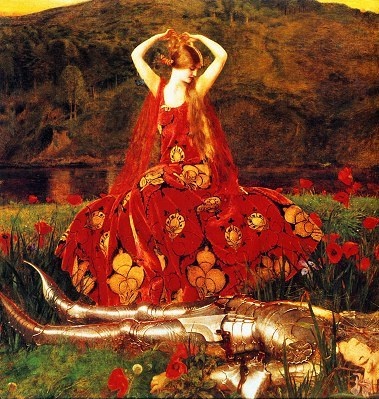
"La Dame Sans Merci" Frank Cadogan Cowper 1926
‘Is it not extraordinary? When among Men I have no evil thoughts, no malice, no spleen – I can listen and from every one I can learn – my hands are in my pockets I am free from all suspicion and comfortable. When I am among Women I have evil thoughts, malice, spleen – I cannot speak or be silent – I am full of Suspicions and therefore listen to no thing – I am in a hurry to be gone – You must be charitable and put all this perversity to my being disappointed since Boyhood – ….I must absolutely get over this, – but how? The only way is to find the root of the evil, and so cure it.’ John Keats, in a letter to Benjamin Bailey, July 1818 [2]
This is a deeply psychological insight into Keats’ anxiety of love and relationships. Toward the end of 1818, only a few months after writing this letter, Keats began to develop an intimate love affair with Fanny Brawne. This was also when his tuberculosis was also advancing into a critical stage. Keats fell deeply and instantly in love with her, and wrote hundreds of letters and notes to her, although none of her letters to him survive.[3]
His letters begin as a new relationship does. Full of hope and love and optimism:
“My love has made me selfish. I cannot exist without you - I am forgetful of every thing but seeing you again - my Life seems to stop there - I see no further. You have absorb'd me. I have a sensation at the present moment as though I was dissolving - I should be exquisitely miserable without the hope of soon seeing you” Oct. 13, 1818 [4]
But his illness and depression progresses as his death impends, his relationship with Fanny grows darker and more accusatory. He was in constant need of reassurance that Fanny loved him as much as deeply as he did her:
”My greatest torment since I have known you has been the fear of you being a little inclined to the Cressid; but that suspicion I dismiss utterly and remain happy in the surety of your Love, which I assure you is as much a wonder to me as a delight. Send me the words "Good night" to put under my pillow.” Feb. 1820[5]
In this letter, “Cressid” references Cressida from the play Troilus and Cressida by Shakespeare and Chaucer. She regarded as a treacherous and faithless lover.
“I see life in nothing but the cerrtainty of your Love - convince me of it my sweetest. If I am not somehow convinc'd I shall die of agony. If we love we must not live as other men and women do - You must be mine to die upon the rack if I want you. I do not pretend to say I have more feeling than my fellows - but I wish you seriously to look over my letters kind and unkind and consider whether the Person who wrote them can be able to endure much longer the agonies and uncertainties which you are so peculiarly made to create - My recovery of bodily hea[l]th will be of no benefit to me if you are not all mine when I am well.” May 1820 [6]
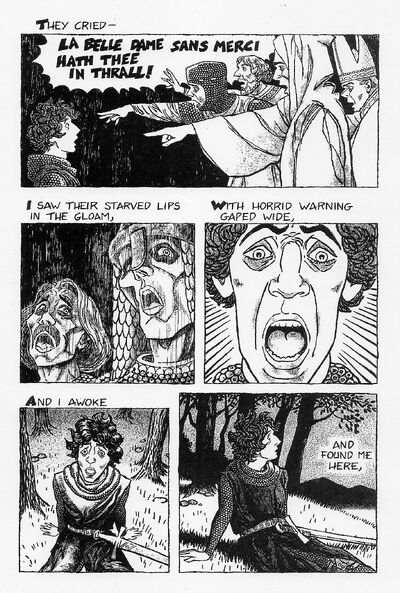
Julian Peters
In the fall of 1820 his health forced him to move to Italy for the remainder of his life, while Fanny stayed in London. At this point, he was so angry at his illness and heartbroken at the loss of her he no longer bear to correspond with her.
In La Dame, we see this angst and frustration play out almost as a dramatic scene. He as the Knight- abandoned by the woman he loves but doesn't understand, also unable to stop the life force being pulled from him as represented by the lake retreating from the sedge. She is the woman with wild eyes, with whom the knight can “neither speak nor be silent,” and for whom Keats (the author) is full of suspicion. Because she cannot speak, the knight takes a risk by falling in love with her beauty without full reassurance of her faithfulness. The consequence is her abandonment of him, as she had abandoned so many men before him.
“You may have altered - if you have not - if you still behave in dancing rooms and other societies as I have seen you - I do not want to live - if you have done so I wish this coming night may be my last. I cannot live without you, and not only you but chaste you; virtuous you.” May 1820 [7]
If Keats intended La Dame to be a literary painting of himself and Fanny, it may at first glance look contrary to his own theory of negative capability, in which he describes the importance of taking the poet’s ego out of the poem and placing consciousness within the object. However, even if he is allowing himself into the poem, his ego hovers just above it. He remains in that space between love and death, and but by allowing his personal narrative into the poem, even adds a darker dimension of possession and the despair of uncertainty.
Loss of Innocence Without Resolution[]

PM Buchan
One of Keats’s greatest influences was William Shakespeare, and one can easily compare the fairy grotto in La Dame to the enchanted forest in Midsummer Night’s Dream. Both spaces present problems with discerning reality from dream states. Within that shift, innocence is lost within confusion and chaos as the characters are deceived into getting what they think they want. In Midsummer Night, it is the partner swapping. Each person falling in love for the wrong person by means of force. In La Dame, it is the knight’s seduction into superficial love for the woman’s beauty.
In stanzas 5 and 7 there is an exchange in which he wraps her about the head, wrists, and waist with flower garlands, and she returns by presenting him with divine food: sweet relish, honey, and manna. This exchange alludes to drug use and sexual congress, at the same time indicating a mutual expression of Keats’s possessiveness:
V.
I made a garland for her head,And bracelets too, and fragrant zone;
She look’d at me as she did love,
And made sweet moan.
VII.
She found me roots of relish sweet,
And honey wild, and manna dew,
And sure in language strange she said—
“I love thee true.”
In Shakespeare’s play, his characters’ relationships were slanted and asymmetrical within the fairy forest, and so is the case with the knight and La Dame. As they made their way to the grotto, their relationship was ambiguous but light. They spent their time outside and in the sunshine. Once they got there, it turned dark and foreboding.
VIII.
She took me to her elfin grot,And there she wept, and sigh’d fill sore,
And there I shut her wild wild eyes
With kisses four.
Why does the woman weep? Given Keats’s history with women, he might be looking at her with a dark optimism, saying she is genuinely in love with the knight, but unable to stop herself from cursing him as it is in her nature. Or she may be feigning her sadness, as women are untrustworthy. Or the knight may have misinterpreted her “language strange;” she may not have said she loves him at all.
Unlike Shakespeare, Keats does not give his protagonists a tidy resolution full of happy marriages and new found self-awareness. Aside from the pale apparitions incriminating her, she disappears with those four kisses. With the acquisition of the knight’s maturity comes a death of loneliness and isolation. The hope of new innocence is brought to the scene by the questioner, who begins the frame of the poem with a question but is not allowed to close it with what he has learned. Instead the poem is closed with the second half of his question repeated, “Though the sedge is wither’d from the lake, /And no birds sing.”
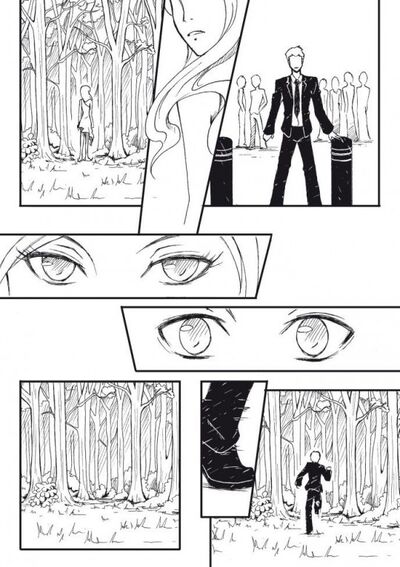
PM Buchan
Relevance[]
Gothic writers were interested in looking for the sublime within the human condition and human interaction with the the force of nature in terms of the supernatural. La Dame explores common gothinc themes of human nature and love in darker, emotional terms and examines areas such as gender, sexuality, and isolation.
Keats explores the Gothic aspects of supernatural sublimity when he examines the abject terror of unknowingly falling in love with a beautiful monster, as did Samuel Taylor Coleridge in Christabel . The historic medieval setting in both poems allows the audience the distance to examine the conversation of sexual love and feminine beauty as being sublime, and what consequence becomes of transgression upon it. Both women in the poems are considered to be predators upon first reading for their unapologetic grasp of personal sexual identity, and their unconventional lead in relationship roles. This leaves both male characters without control which is reflected in the natural imagery and emotional description. The knight is isolated, lost among his ghostly predecessors after his encounter, unable to withstand the power of the supernatural force he encountered. Christabel is also isolated in her muteness, unable to speak the truth of her seduction to her father, as he is also being seduced.
La Dame encompasses gothic tropes that are also common in femme fatale fiction such as seduction by compulsion and loss of identity. In terms of sexual agency and the vigin/whore dichotomy which allows the women their villiany, the faery woman remains enigmatic. She is neither, and yet also both. Keats does not portray her as an innocent, but the knight pursues her according to courtly customs. If she had been of a lower class, he would not have bothered courting her. We see that by the fifth stanza, when the knight has wrapped her in garlands, he has claimed his possession of her and simultaneously lost his ability to resist her. By eating the food she offers and ingesting her tears, he accepts her being and body into his body and therefore loses the part of himself that is able to defend himself. Then as he sleeps, he encounters the men who inform him of his lapse of reason and he knows it is too late. The consequence is of course the loss of what he thought was love, isolation, and complusion to never leave the withered lake.
Coleridge’s Geraldine also deceives, seduces, and takes the identity of Christabel. By contrast, she is an illustrated manipulator of the virgin/whore dichotomy throughout his poem. She presents herself as a damsel and a virgin, although when she is in the bedroom with Christabel she becomes aggressive. Coleridge's third person perspective gives the reader a voyeristic insight, allowing for a much broader scope into her character, whereas Keat's first person narrative from the knight is very limiting. Despite the reader's allowance of transgression to watch the bedroom scene in Christabel, what exactly is done to her by Geraldine to make her mute and possessed is unknown, as it is La Dame.
Keats's concept of the beauty of nature and love turning predatory is not new or revolutionary, but the imagery of joy parenthesized by bleakness, with his undertones of possession and sexual desperation makes this an innovative text of the Romantic period.
Adaptations[]
Pinterest search with artist renditions
Julian Peter's beautiful comic interpretation
Comic Book Series by PM Buchan and Karen Yumi Lusted
Robert Anning Bell's Art Nouveau illustrations.
IMDB page to short film "La Belle Dame Sans Merci"
Citations[]
[1] "Negative Capability." - Keats' Kingdom. 1 Jan. 2004. Web. 1 Jan. 2015. <http://www.keatsian.co.uk/negative-capability.php>.
Written and assembled by Diana Kendall-Huss
- ↑ http://www.gutenberg.org/files/35698/35698-h/35698-h.htm#f33.1
- ↑ http://www.gutenberg.org/files/35698/35698-h/35698-h.htm#f33.1
- ↑ http://encyclopedia.thefreedictionary.com/John+Keats#cite_ref-8
- ↑ http://www.englweb.umd.edu/englfac/JRudy/Keats-letters.pdf
- ↑ http://www.englweb.umd.edu/englfac/JRudy/Keats-letters.pdf
- ↑ http://www.englweb.umd.edu/englfac/JRudy/Keats-letters.pdf
- ↑ http://www.englweb.umd.edu/englfac/JRudy/Keats-letters.pdf
